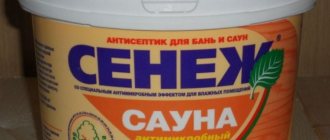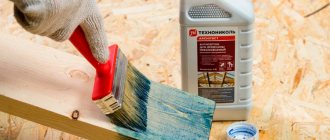After the floorboards have been laid and the lining of the ceiling and walls of the room has been sewn, the stage of choosing a coating or impregnation for the wood, especially the lower tier, begins. You cannot even try to cover the floor in a bathhouse with ordinary varnishes and paints; a completely different environment, high humidity and temperature can destroy the wood within a few months of service.
Simple varnish can protect floorboards as well as paint
Do I need to treat the floor in the bathhouse?
Every amateur asks this question, but a professional will undoubtedly answer: “Yes,” but such an answer is not enough, because in order to choose the right impregnation, you need to become familiar with its purpose.
First of all, impregnation is applied as additional protection of wood from moisture. Impregnation clogs the pores, preventing the processes of rotting and corrosion. Special impregnation protects not only the finishing coating, but also its base, for example, joists. It is also worth noting that impregnations are perfectly combined with other materials for processing, for example, with a primer, which is applied before painting the floor in the dressing room or rest room.
A floor treated with impregnation will be distinguished not only by its durability, but also by its appearance, because many processing agents contain coloring components that emphasize the natural beauty of wood. As you may have noticed, impregnation is an important part of the construction work complex, so it is important to determine for yourself what to impregnate the floors in the bathhouse with.
Homemade recipes
There is a recipe for homemade wax impregnation, which includes beeswax and linseed oil, the ingredients are taken in equal proportions. The grated wax is melted in a water bath, and then it is mixed with the second component and allowed to cool.
It is recommended to use harmless protective materials to impregnate the walls of the steam room. The use of oils allows you to create a greasy film on the surface of a wooden structure and protect the wood itself from penetration deep into dirt. There is one minus here. For some time after contact with the treated surfaces, a greasy film will be felt, but soon the oil will be absorbed and partially erased, leaving only a protective film.
A good result is obtained after using melted natural wax. This impregnation is easy to do with your own hands. But the surface must first be thoroughly cleaned, degreased and only then wax applied.
What types of impregnations are there?
When you come to a hardware store, you will be faced with a difficult choice of your impregnation, because on the shelves there will be a variety of protective equipment, for example, you can find bath floor oil, which is used to protect the floor from moisture, and next to it there will be an antibacterial agent. Both of these impregnations will be extremely important for the floor in the bathhouse, but sometimes you want to save money.
Floor impregnations are divided as follows:
- Moisture protection products;
- Antibacterial;
- Compositions that protect wood from fire;
- Brighteners and darkeners.
Let's talk in detail about each of these groups.
Moisture protection products
penetrate into the natural pores of wood, after which they dry and reliably clog them. The degree of such protection depends entirely on how deeply the protective composition penetrates. The penetration rate of the solution is usually indicated on the label. It is also worth remembering that not every product is suitable for your wood, so always check with the seller whether such impregnation can be used for your bath.
Antibacterial protection
It is extremely important for a bath, because in an environment with high humidity, ideal conditions are created for the proliferation of various bacteria and pathogenic microorganisms. First of all, wood needs such protection, because under the influence of such bacteria it begins to rot. Bacteria can also harm humans, but the chance of this is extremely low. This impregnation is the ideal answer to the question of how to impregnate the floors in a bathhouse from rotting, because they provide reliable protection and are also ideal for wet rooms.
Fireproof impregnations
They are rarely used in bathhouses, but they are worth talking about, because they are a good impregnation for wood located near the stove. This impregnation creates a non-flammable layer on the outside and in the pores of the wood, but does not provide complete protection against fire, so never forget about other precautions.
The last group of darkening agents is purely decorative, but many of them contain components that protect wood from moisture and microorganisms. Darkening agents are used to impart some shade to natural wood.
Bleaches
rarely classified as impregnations, but they are also worth knowing about. During use, the wood in the bathhouse begins to darken. Some bathhouse owners replace the wood completely, but you can try bleaching it with a special product. More often it is used on darkened spots, and not on the entire surface of the floor.
It is also worth mentioning how to treat logs in a bathhouse from rotting. Joists require a more careful approach, but these impregnations will also cope with their protection.
Causes of wood rotting
Wood is a porous structure made of plant fibers that absorbs water well. When the material humidity is above 15%, the risk of infection increases.
Wood is an organic medium in which, under certain conditions, bacteria and fungal spores actively develop. Microorganisms need temperatures in the range from 0 to +50°C, humidity above 80%.
Favorable factors for the development of mold and fungi are considered to be freezing of boards, stagnation of indoor air, and possible contact with soil.
Wood is an organic medium in which, under certain conditions, bacteria and fungal spores actively develop.
How effective are impregnations?
Impregnations will significantly reduce the chance of rot, but will not remove it completely. How effective impregnations are depends entirely on the manufacturer and the components he used.
When soaking a wooden floor in a bathhouse, do not forget about natural prevention:
- Ventilate the room after each visit to the bathhouse;
- Clean the area to minimize the chance of unwanted microorganisms;
- Do not leave the sauna without heating for a long time.
Briefly about the main thing
To process lining in a bathhouse, materials that are resistant to temperature changes, humidity, and washing are used. Also important is inertness to fungus, mold, bacteria, and a safe composition for humans.
When heated, many materials release toxins and other harmful substances, so the use of antiseptics, fire retardants, drying oils, varnishes with solvents and acrylic resins is unacceptable for the steam room.
For walls and ceilings, impregnations, mastics, oils and some varnishes are used. For shelves only oil or wax based formulations. This prevents the formation of a thick film to avoid burns.
Bleach is used in any room of the bathhouse, but before further processing of the wood, it is necessary to wait until the chlorine evaporates and the hydrogen peroxide decomposes.
Antiseptics and fire retardants are classified as pre-treatment agents for wood, but are not used as independent coatings. They protect the lining and help reduce the consumption of the finishing coating.
Source
Wood floor treatment
Having chosen what to treat the wooden floor in the bathhouse with, you can get to work. This treatment is quite simple to perform, and following our instructions, you will create the perfect protection for your floor with your own hands.
Impregnation of a wooden floor in a bathhouse:
- Before treating the floors in the bathhouse against rotting, you must carefully sand the surface to be treated. Get rid of roughness and unevenness on the floorboards using a sander. You can perform this step manually using sandpaper, but you will spend a huge amount of effort and time.
- Clean the floor from any wood dust using a vacuum cleaner or broom. Next, wipe the floor with a damp cloth to remove any remaining dirt.
- Before treating the floors in a bathhouse in a sink or other room, wait until the wood is completely dry, after which you can safely begin processing. We recommend applying the composition with a roller, because processing is much easier and faster. You will also have to purchase a brush, because in hard-to-reach places, for example, corners, you cannot do without it.
Typically, impregnation is applied in several layers, and these layers can be of different compositions; for example, you can combine antibacterial and moisture-proof impregnation. When applying several layers, remember that between each of them it is necessary to maintain a certain time interval for drying, which is almost always indicated on the product label.
After finishing the treatment, you can cover the floor with varnish or paint, but this is not necessary.
What to choose
Specialized retail outlets offer a huge number of impregnations for wooden surfaces; they differ in use, form, and composition.
Before you make a purchase of one or another protective equipment, it is recommended to clearly determine what tasks it should cope with, namely:
- what surface will be treated (floor, ceiling, benches, shelves in the steam room, the entire room);
- will an additional decorative coating be used or will the surface after treatment remain the same as before;
- will the degree of moisture protection inside the bath be sufficient;
- Is the application method convenient?
An essential indicator of high-quality impregnation for baths, including those made from logs, is the combination of its moisture-proof properties with the ability not to prevent the skin from breathing. Since the presence of film leads to blockage of the wood structure and subsequent problems leading to damage to the surface. It is also worth paying attention to the environmental friendliness of the selected antiseptic. Otherwise, low-quality goods at high temperatures and high levels of humidity in the room will release harmful substances.
If impregnation is selected for treating floors, then after its application there should not be a slippery coating. Tabletops and benches should be treated with products designed for regular wet cleaning. There are shelf impregnations on sale that can completely penetrate the wood structure and prevent the formation of burns on the body at high temperatures.
Why is it necessary to treat concrete?
Impregnation has a strengthening effect on a new concrete floor, but it can also be used to treat an old floor with some defects to restore its original appearance and properties.
Speaking in more detail about its effect on concrete, we can highlight the following:
- Impregnation will increase the wear resistance: the floor will better withstand temperature changes, moisture, and mechanical stress, such as impacts;
- The concrete floor constantly crumbles, creating dust. Impregnation will help get rid of this problem by binding small particles of concrete;
- The treatment will also significantly increase the service life of a new or slightly worn floor;
- An untreated concrete floor will need repair, so treating it is also a money saver.
Material safety
When choosing impregnation for lags, you need to take into account that at home it is permissible to use only safe compounds. Thanks to this, the wood will be protected from insects, and the health of people living in the house will not be affected.
When purchasing a chemical, you should familiarize yourself with the components included in its composition.
Based on the above information, it is clear that today there are several options available for processing natural wood logs. All of them help solve problems associated with insects - pests and microorganisms that cause decay processes. Both of these activities must be carried out without fail.
Types of processing agents for concrete
First of all, impregnating products for concrete floors are divided into organic and inorganic.
Organic impregnations can be made based on epoxy, acrylic or polyurethane. The most popular are impregnations made on the basis of polyurethane, because they are sold at a fairly low price, and their performance qualities often exceed those of competing bases.
After you have applied the composition, it will begin to penetrate the pores of the concrete, reliably bonding its entire surface. This way you will ensure reliable moisture resistance and also get rid of concrete dust.
Inorganic impregnations are less popular. Their method of action is quite simple: they convert soluble materials into insoluble ones, significantly increasing their resistance to various solvents, for example, acetone.
This impregnation for bath floors also has a classification according to purpose:
- Strengthening;
- Dust removal;
- Moisture-repellent.
Strengthening agents are absorbed into the upper layers of concrete and harden, as a result of which the floor acquires increased resistance to various mechanical influences.
Dust-removing impregnations protect concrete from abrasion. They additionally bind the surface of the concrete floor, which gives it significant strength. This bath floor treatment is ideal for painting. To give this treatment an extra boost, rub fine sand or silica powder into the concrete floor before applying the treatment. As a result, you will get a durable floor on which you will not slip.
Water-repellent impregnation for bathhouse floors is one of the best solutions. First of all, it is worth noting the low price and good protection of concrete floors. Such impregnations simply clog the pores of the concrete, preventing moisture from penetrating into the thickness of the floor.
This way you prevent not only moisture from entering, but also various chemicals that can lead to the formation of efflorescence. Harmful microorganisms will also not be able to enter the concrete and destroy it. We recommend using two-component water-repellent impregnations, which are widely available on the Russian market.
Be careful! Such impregnations enter into a chemical reaction with the concrete itself, so it is important to know whether your concrete is suitable for them or not. If you don’t know what the filling in your bath consists of, then you can limit yourself to a simple experiment.
Apply the impregnation to a small area of concrete, wait for it to dry and look at the result. If the concrete has not crumbled or darkened, and the impregnation is in a strong, uniform layer, then you can safely begin treating the entire floor.
The better
Let us clarify that treatment, in our understanding, is a preventive measure to prevent the future appearance of rot, mold, blue stains, infestation with wood-boring beetles and similar misfortunes. Or medicinal if infection has occurred. There are also compositions to reduce the flammability of wood.
In the first two cases we are talking about antiseptics - substances that kill fungi (fungicides) and insects (insecticides). In the third case - about fire retardants, which slow down fire or make wood non-flammable.
Is it necessary to treat the lining in a bathhouse with these compounds? Optional. They are good for preventing infections, they will keep the sauna from burning out completely, but they have restrictions on their use in the steam room
It is also possible to pay attention to impregnated wood
What to use in the steam room
While we're talking about this, there are a couple of products that can be used in a steam room too. However, their effectiveness is very limited.
For example, if you treat the paneling in the steam room of a bathhouse with “Belizna” bleach or its analogues, you can quickly get rid of the blue stain - this is the name of the fungal infection of wood, with which wood is often sold, since it does not affect the strength, it only spoils the appearance of the lumber.
Fungal infection - blue
BY THE WAY! Why Whiteness? Because there are a number of different antiseptics for wood, which contain nothing but sodium hypochlorite, as in “Belizna”. Well, maybe the concentration is different and the price is different.
After use and achievement of the result, “Whiteness” is washed off and ventilated (!more about ventilation in the bathhouse in a separate material). You can use the bathhouse when you can no longer smell the smell.
As a close analogue of bleach, you can use hydrogen peroxide - also a strong oxidizing agent that does not allow fungi to live.
For mold, you can use boric acid or borax, but now boron compounds are considered toxic, and among the cumulative poisons, that is, those that accumulate and are not eliminated from the body. The only good thing is that the poison is weak, it takes a lot of it to get poisoned.
But it’s not worth living with mold either; you die from it faster than from boron. If it starts up, then it’s no longer a matter of whether it’s a steam room or not, we have to start fighting. Until you get rid of it, you can’t use the bathhouse.
However, this applies to all infections - the more serious they are, the more serious the remedies. It’s better to treat the lining in a bathhouse with a professional antiseptic that will combat your problem, and then wash everything, than to change the entire lining. But it’s better to change the entire paneling than to risk your life because of black mold. With wood-boring beetles, the same strategy - while it makes sense to fight - we fight, if there are too many of them - we burn the affected tree.
Treatment inside other bath rooms
In this case, there is only one difference from the steam room: in other rooms you can use prophylactic agents. That is, do not wait for a problem, but prevent its occurrence by poisoning the lives of pests in advance.
Since there is no steam room heat in other rooms, all these poisons will not evaporate and be inhaled by humans.
Therefore, you can safely use antiseptics and fire retardants, whichever you like. In the washroom you will want to use non-washable compounds, but look at the label: if it says that it is for the exterior and not the interior, then it is better not to. It's better to update from time to time.
IMPORTANT! Antiseptics can be found on sale not only in the form of separate formulations, but also in the form of primers, which precede the application of varnish, glaze or paint. If you are going to paint with something, choose the right primer and you will not need to separately use an antiseptic.
Applying impregnation for concrete floors
Treating a concrete floor, like treating a bathhouse floor from rotting, does not require any skills. Following our instructions, even a beginner can easily cope with this task.
We impregnate the concrete floor:
- Before starting processing, it is necessary to carefully prepare the surface. Get rid of various irregularities with sandpaper. If you are going to restore an old floor, then carefully tap it into the voids and seal all the cracks. After you have made a smooth concrete surface, remove large debris and vacuum; you can also use a damp cloth, but this is not necessary.
- Having prepared the concrete floor, you can begin impregnating it. Strengthening compounds are applied in two different ways. You can apply the impregnation with a roller to the floor surface, or pour it onto the floor and distribute it evenly with the same roller.
- Next, you need to carefully read the instructions, although it is better to do this before starting work. First of all, pay attention to how long it takes to dry the first layer. Once you know the time, wait for it. After the primary treatment has dried, you need to start pouring the next layer, however, a slight difficulty arises here: you must dilute the impregnation with a small amount of water, which the manufacturer usually indicates on the packaging. Apply the second layer in the same way as the previous one, then wait 20-30 minutes (the exact time is indicated by the manufacturer). When the layer has dried, remove excess impregnation with a squeegee and wash the floor. This concludes the processing of the concrete floor.
Conclusion
Don’t be afraid to start this work yourself, because now you know how to treat the logs in the bathhouse, as well as the floor laid on them. In addition, you can easily handle concrete processing, saving a lot of money. Also remember that work done yourself can sometimes turn out better than the work of a professional.
Useful video
Yes, it was surprisingly difficult to find a sane video. We stopped at this video because in it you will find references to compounds that were not found in our text - from the company TEKNOS. She is famous, she has facilities in Russia. Why not?
***
Finally, we would like to invite all of you to be more demanding customers, ask for the composition of the chemicals you are going to purchase and the certificates for it. Your health depends on this, so I would like to see real information, and not streamlined formulations.











